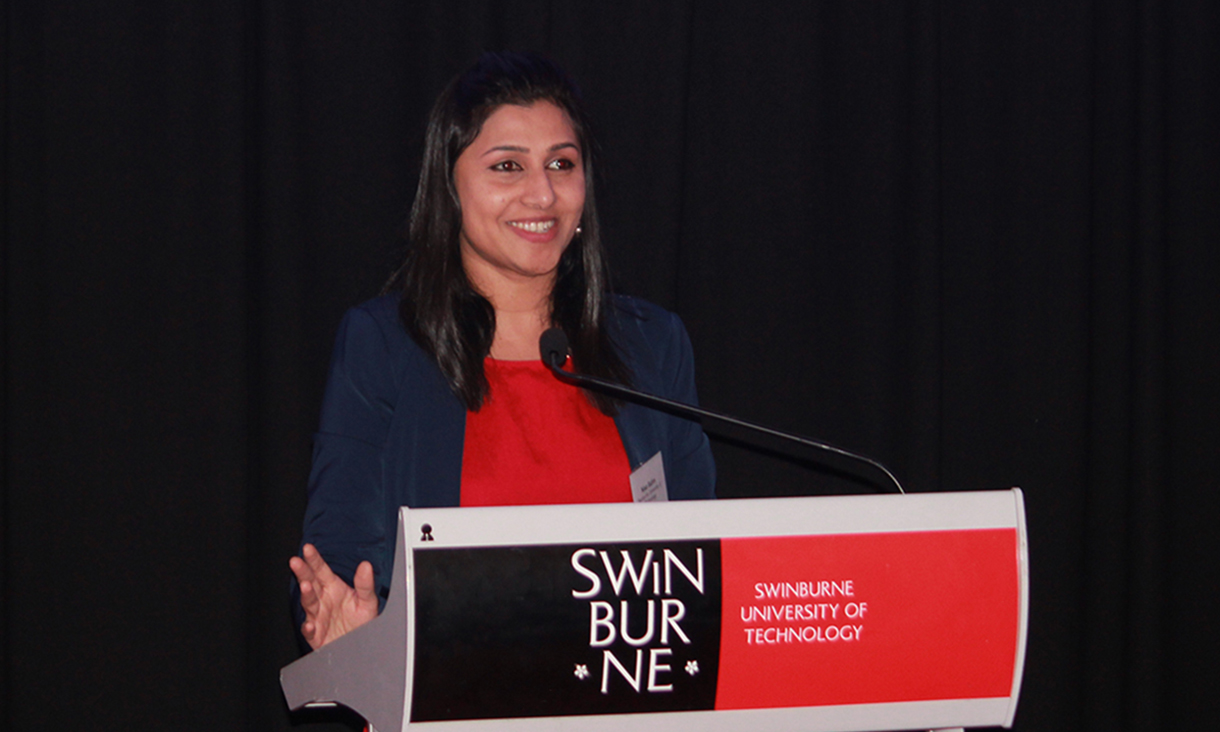Dr Nisa Salim recognised for high-quality approach to science

Dr Nisa Salim’s work is driven by the need to develop greener, safer and more sustainable transport systems.
In summary
- Swinburne Vice-Chancellor’s Initiative Research Fellow Dr Nisa Salim has been awarded the 2020 Phillip Law Postdoctoral Award for the Physical Sciences by the Royal Society of Victori
- She develops multifunctional materials with nature-inspired designs to solve challenging problems
Swinburne University of Technology’s Dr Nisa Salim, has been awarded the 2020 Phillip Law Postdoctoral Award for the Physical Sciences by the Royal Society of Victoria.
The award is for excellence in scientific research by an early career researcher in the physical sciences within seven years of completing a PhD from a Victorian research institution.
Dr Salim received her PhD in materials engineering from Deakin University and is currently a Vice-Chancellor’s Initiative Research Fellow at Swinburne.
She develops multifunctional materials with nature-inspired designs to solve challenging problems.
“The potential to use nature as a template for developing new technologies is exciting,” Dr Salim says.
Using a novel molecular self-assembly approach Dr Salim develops materials in various length scales and dimensions, creating working prototypes or devices from these materials.
Recent examples of her research include highly sensitive honeycomb-like porous foams for sensing applications, marine sponge-like fibres for energy storage and feather-like nanofibre networks for oil spill cleaning applications.
Carbon fibres are key to sustainable transport systems
“The porous carbon fibres are important materials that exhibit meso- micro- and macro- sized porous features and have high surface area, high oil adsorption and energy storage capabilities,” Dr Salim says.
Stronger than steel, lighter than aluminium and electrically conductive, these fibres are essential multifunctional materials for the future of sustainable and smart transport systems.
Dr Salim’s work is driven by the need to develop greener, safer and more sustainable transport systems.
“Greenhouse gas emissions from the transport sector are growing faster than emissions from any other sector in Australia,” Dr Salim says.
The porous carbon fibres can be used to create ‘structural supercapacitors and batteries’ that can store electrical energy in a structural component, such as a car, aircraft or drone body.
“With electric vehicles predicted to represent 90 per cent of all cars and light commercial vehicles on Australian roads by 2050, structural supercapacitors have the potential to revolutionise our transport by storing electrical energy in lightweight structural components of a vehicle’s body instead of in heavy, sole-purpose batteries,” Dr Salim says.
“Composite batteries are ideal materials to address the challenges of higher pay load and longer shelf life, and thus perform double duty both as body part as well the battery to power the vehicle.
“When this becomes a reality, we can deliver on-demand emergency medical and food supplies to those who are affected and isolated during flood, bushfire, or even during pandemics.”
Dr Salim and her research team are working with Australian small to medium enterprises (SMEs) to demonstrate the exciting potential of these new multifunctional materials. She is leveraging her collaborative relationships with a global academic and industrial network to take this cutting-edge research from the lab to the market place.
Dr Salim is a strong supporter of women in Science, Technology, Engineering, Mathematics and Medicine (STEMM).
“It is critical to get adequate support for early career researchers, especially women, to get encouragement and support to pursue their career,” she says. "Always look for how to harness the opportunities that keep you ambitious.”
Dr Salim recently presented a public lecture, hosted by the Royal Society of Victoria on her work, titled “Inspired by Nature: Engineering Multifunctional Materials,” where she was presented with the Phillip Law Postdoctoral Award and a prize of $3,000.
-
Media Enquiries
Related articles
-

- Student News
- Science
- Sustainability
Introducing tomorrow’s global science communicators
Start Talking is Swinburne’s unique video-based public speaking competition, exclusively for undergraduate students
Monday 08 December 2025 -

- Technology
Swinburne-led network to guide AI use in youth services
Swinburne’s Dr Joel McGregor, Dr Linus Tan and Dr Caleb Lloyd have established the Responsible AI in Youth Sectors Network. The collaborative network aims to guide the fast-growing use of artificial intelligence in youth services across Victoria.
Friday 12 December 2025 -

- Astronomy
- Technology
- Health
- Science
- University
- Sustainability
- Engineering
Swinburne highly cited researchers reach the top in 12 fields
Ten Swinburne academics have been named on the Highly Cited Researchers 2025 list, released by Clarivate
Tuesday 02 December 2025 -

- Science
- Engineering
Swinburne secures grant to advance next-generation metamaterials research
Swinburne physicist Dr Weibai Li has received a Discovery Early Career Researcher Award from the Australian Research Council
Tuesday 02 December 2025 -

- Technology
- Health
- Science
- University
$1.2m ARC funding to boost national X-ray spectroscopy capability through Swinburne and QUT partnership
Swinburne has secured $1.2 million in the latest Australian Research Council Linkage Infrastructure, Equipment and Facilities scheme round
Tuesday 02 December 2025

